The Importance of June 16th to James Joyce
And a New Graphic Biography of the Famously Obtuse Writer
Richard Ellmann, in his then (1959) definitive biography of James Joyce, the Irish writer and author of the nearly impenetrable novel Ulysses, inspired by the Odyssey (and the even more impenetrable Finnegans Wake, which contains my all-time favorite sentence of puns—“nobirdy avair soar anywing to eagle it”), starts us off—:
On June 10, 1904, Joyce was walking down Nassau Street in Dublin when he caught sight of a tall auburn-haired young woman, walking along with a proud stride—sauntering—in a manner suggesting that she was approachable. When he spoke to her, she answered pertly enough to allow a conversation to ensue. ... Joyce found that she was employed as a chambermaid at Finn’s Hotel, a slightly exalted rooming house, and her lilting speech confessed that she was from Galway. Her name was a little comic, Nora Barnacle, but this too might be an omen of felicitous adhesion.
After some little talk, they agreed to a date on June 14. But Nora failed to appear at the appointed time and place. Nevertheless, Joyce persisted, and they finally met in the evening on June 16—with such life-changing and -shaping consequences that Joyce set that date for the day in the life of Leopold Bloom that is exhaustively in painfully endless detail described in Ulysses, on a day known thereafter as Bloomsday.
Joyce and Nora walked to Ringsend, on the south bank of the Liffey. The attraction between them was immediate, wrote Brenda Maddox in Nora, and Nora, who had to be back at Finn’s by half-past eleven, wasted no time. To Joyce’s grateful astonishment, she unbuttoned his trousers, slipped in her hand, pushed his shirt aside, and, acting with some skill (according to his later account), masturbated him.
Subsequently, there are several references to the incident in Joyce’s letters. After another date, Joyce took one of Nora’s gloves home with him, and he writes to her to say that he has slept with it.
“Your glove lay beside me all night—unbuttoned—but otherwise conducted itself very properly—like Nora.”
In August, he tells her that what happened was “a kind of sacrament, and the recollection of it fills me with amazed joy.”
Five years later, while on a trip to Dublin from where they lived in Trieste, he writes to her: “It was not I who first touched you long ago down at Ringsend. It was you who would slid your hand down down inside my trousers ... and frigged me slowly until I came off through your fingers, all the time bending over me and gazing at me out of your quiet saintlike eyes.”
On that night, he tells her in another letter, “you made me a man.”
I’ve often wondered about this episode what Joyce must have eventually pondered: where and how did Nora learn to do what she did? Well, it took him five years to fully comprehend what it meant.
Maddox continues: “Nothing in Joyce’s experience had prepared him for the frankness and directness of Nora’s sexual approach. Instead of losing respect for her, he fell in love for life.
“In his heart, Joyce knew that young girls do not do such a thing for the first time unless they’ve been instructed by a man. ... Five years later, his suspicions would burst out and he would remind her accusingly how readily she had embraced him, how shamelessly she had touched him first and let her hands wander over his body. Had she never, he asked belatedly, touched a penis before her fingers made their way to his?”
They were inseparable immediately thereafter. Nora went with Joyce in 1904 when he left Ireland to live in Europe. Before they eventually married in 1931, she had three children with Joyce, one a miscarriage.
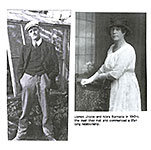 |
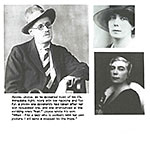 |
As John Banville says in reviewing a new biography of Joyce for The New Republic (August 2, 2012), before their date on June 16, “Joyce was an overly precocious aesthete with a taste for debauchery, but Nora took him in hand, figuratively and literally, and made of him a man, and an artist.
“In the coming years, it would be Nora, with her simplicity and shrewdness, her generosity of spirit and, above all, her earthiness, who would show him the direction his art must follow. Without her, there would probably have been no Molly Bloom or Anna Livia Plurabelle ... or even no Stephen Dedalus.”
In his biography of Joyce, Ellmann glides quickly over this apocalyptic event, saying “they went walking at Ringsend, and thereafter began to meet regularly.”
He goes on (without mentioning what, exactly, happened during that walk at Ringsend):
“To set Ulysses on this date was Joyce’s most eloquent if indirect tribute to Nora, a recognition of the determining effect upon his life of his attachment to her. On June 16, he entered into a relation with the world around him and left behind him the loneliness he had felt since his mother’s death. He would tell her later, ‘You made me a man.’”
Ellmann
probably knew about the masturbation, but literary scholarship in those days
(the  nineteen fifties) was a much more polite—even effete— enterprise than it
later became when it was more interested in raw unabashed truth than good
manners.
nineteen fifties) was a much more polite—even effete— enterprise than it
later became when it was more interested in raw unabashed truth than good
manners.
And the author of the new 2013 graphic biography, James Joyce: Portrait of a Dubliner (230 6x9-inch pages, b/w; Arcade paperback, $16.99), Alfonso Zapico, is likewise more fastidious than forthcoming—although for those in The Know, showing Joyce shuddering in Nora’s embrace is acknowledgment enough of the facts to justify Joyce’s immediate infatuation with the woman.
A BIOGRAPHY OF A WRITER is inherently difficult to produce: all the important “action” for a writer is in his/ her head. But a prose treatment can achieve something like the necessary insight. For a graphic biography—an enterprise essentially more visual than verbal—the task veers off in the direction of impossible. With Joyce, however, it is less impossible.
Although Joyce is recognized as a genius with language, he also led a life outside his head. He moved around Europe a lot, and he enjoyed the nightlife in the cities where he lived. And he was an impoverished drunk. Zapico makes the most of the possibilities.
He shows Joyce and Nora leaving Ireland for Paris in 1904. They are not married because Joyce didn’t believe in marriage. He didn’t just neglect to marry Nora: he rejected the whole idea of marriage. Getting a priest or lawyer to “ratify” their relationship was out of the question: Joyce believed entering into a formal marriage was the first step toward subjugation to the kinds of conventional behaviors that he found coercive. He defiantly left the Roman Catholic church for similar rebellious reasons. And when he finally married Nora in July 1931 in London, it was probably to establish officially his being a resident of the city, which was necessary under British law for securing his inheritance for his son.
In
going to France in 1904, Joyce is hopeful for a job teaching with Berlitz, but
when he arrives in Paris, there are no such jobs. Not right away. Joyce and
Nora settle in a Parisian suburb, Pola, and soon, a Berlitz job shows up— in
Trieste, not Paris. And when that job ran out, Joyce hired himself out as a
teacher of English. Sometimes he worked again for Berlitz. Usually, though, he
was self-employed. Or, rather, self-unemployed. 
With no job, he has no money. Zapico shows him continually asking his brother Stanislaus for money, and Stanislaus always complies—although less willingly as Joyce’s entreaties continue and continue and go on. Joyce spends money recklessly, and he is always asking friends and acquaintances for money—sometimes at the very moment of their initial meeting!
“Can you spare me a couple of pounds,” he’d say.
When not teaching, he wrote constantly. He put pencil to paper as soon as he woke up in the morning, and he often didn’t bother to get out of bed to deploy both pencil and paper.
With the 1914 publication of Dubliners, his collection of 15 short stories, Joyce emerges from complete obscurity: other writers, critics, and literary scholars take notice. They realize, suddenly, that they have a genius in their midst.
And
Joyce, of course, encouraged this conception of his attainments. He was, after
all, convinced of his genius himself. It becomes the lever with which he pries
donations from everyone he comes in contact with. And most of them (realizing
that they are in the presence of genius) donate. 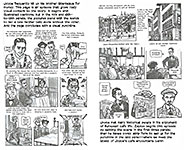
A literary magazine, The Egoist, began publishing fragments of Joyce’s work, serializing excerpts from, first, A Portrait of the Artist as a Young Man (published in 1916), then Ulysses (1921). As an established genius, Joyce qualified for various grants of money, usually organized by Ezra Pound and William Butler Yeats, both of whom believed in Joyce’s literary genius.
Pound and Yeats arranged with a foundation to pay Joyce, the a-borning genius, 75 pounds on a regular basis. In 1917, an anonymous donor gave Joyce 200 pounds and began sending him 50 pounds every 3 months for as long as the war lasted. The donor was Mrs. Rockerfeller-McCormick, the millionaire patron of other artists, including Carl Jung. She decided, based on Joyce’s eccentric lifestyle, that he should be analyzed by Jung; when Joyce refused, she ended her patronage in 1919.
But Joyce’s publisher, The Egoist’s editor Harriet Weaver, was also a donor, and she persisted.
In February 1919, Weaver gave Joyce a 5,000 pound war bond yielding 250 pounds a year; in 1920, she bestowed another 2,000 pounds. That came to 350 pounds a year, more than 11,000 pounds a year in today’s monetary equivalent ($15,000).
Joyce should have had financial independence, but he was incapable of living within his means. His apartment in Paris cost 300 pounds a year, almost his entire bankroll. And Joyce loved dining out in fine restaurants, traveling by taxicab, and drinking, and tipping extensively (five-franc tips for one-franc drinks)—to the extent that he wildly exceeded his income and therefore still had to beg money from friends and supporters, asking everyone he knew to donate to his welfare so he would be free to write.
If someone who regularly donated to Joyce was delinquent with his/her contribution, Joyce would send out a blunt reminder: “I shall be greatly obliged if your monthly cheque arrived punctually.”
Many
nights Joyce spent whoring and/or carousing until the wee hours. The later the
revile, the more likely he’d perform “his signature dance, an inspired
approximation of a jig. His jumps, whirling arms and rubber-legged kicks
somehow managed to appear both clownish and graceful to delighted onlookers,”
saith Kevin Birmingham in The Most Dangerous Book: The Battle for James
Joyce’s Ulysses. 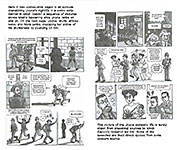
Joyce regularly (religiously?) drank to excess. That was his other signature performance. One may suppose, then, that his days began with his recovering from a hangover. And that may explain the seeming incomprehensibility of Ulysses and, later, Finnegans Wake. They were both written by a drunk with a hangover. Ha.
In
1920, Joyce finally moved to Paris, his original European destination. There,
he was already regarded as a famous writer. 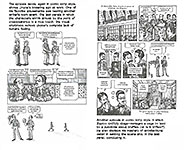
Joyce
suffered periodic attacks of iritis, inflamation of the iris of the eye. The
attacks were painful, often sending him to bed for days (and then, unable to
write, he played with words and scenarios in his mind). He endured several surgeries
and other treatments on his eyes, and he wore a patch over whichever eye was
afflicted at the moment. Toward the end of the book, Zapico shows Joyce going
slowly going blind with iritis; conjunctivitis had turned into episcleritis by
1923 or so. His eye problems were symptomatic of syphilis, which has a
particular affinity for the eyes; Zapico leaves this out. 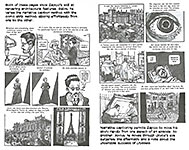
As we see on the accompanying pages, Zapico shows Joyce bedridden and subjected to a treatment with leeches that were intended to extract blood from the eye. Birmingham is more detailed, not clinically but personally:
“Nora stayed in the room next to Joyce’s and helped put the leeches around his eye. The nurse would hold one of the writhing bodies in the folds of a napkin and place its mouth on Joyce’s canthus, the corner of skin where the eyelids meet. ... The leeches would loll and hang off his face until they filled up with blood from the anterior chamber of his eye. Nora helped retrieve ‘the creatures,’ as she called them, when they fell on the floor around his bed. In the evening, through the night and well past dawn, James Joyce lay awake screaming.”
AFTER THE 1916 PUBLICATION of A Portrait, Joyce began work on Ulysses. Ulysses was built upon a scaffold, a schematic understanding of his novel’s events loosely tied to episodes from Homer’s Odyssey. Installments were published in Little Review.
In 1920, Little Review was put on trial in October for publishing immoral and obscene excerpts from Ulysses; in the U.S., the magazine was confiscated and burned. The publication of Ulysses was banned in America until 1933. When the ban was lifted late that year, Random House immediately published it. It sold out at once. The book’s several highly publicized encounters with the tut-tutting morality police doubtless paved the way to success in the marketplace.
Ulysses was finished in late 1920, and expatriate Sylvia Beach arranged for her famed bookstore, Shakespeare and Company, to publish the book in 1921.
Ulysses made Joyce famous. Hundreds said they loved it (but few said they understood it—and even fewer who talked about it had actually read it). Its seeming complexity made it perfect for studying in the ivied halls of higher academe. Perhaps it was Joyce who said that if Ulysses were adopted by American college English courses, his fortune was made. It was, and it was.
Someone related a perhaps apocryphal anecdote: a friend asked Joyce how the writing was going, and Joyce said it was going well: “I have decided on the words for a sentence, and now I am deciding on their order in the sentence.”
Seems an accurate statement about both his working and the book.
Zapico quotes Joyce as saying Ulysses is not a serious work; he hopes that no reader will attempt to find a moral in the book. He was, doubtless, jesting.
In
1923, Joyce began work on Finnegans Wake, the title taken from an old
Irish ballad about a dead drunk who wasn’t dead; he would spend the next 17
years at the task. 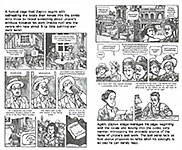
This new book was a seething kaleidoscopic of puns, double entendres, and other wordplay and syntactic gymnastics. Birmingham writes that Joyce was “tunneling into a denser, more obscure novel.” He continues:
“Finnegans Wake is written in the weltering language of dreams. Words spill out of definitions and syntax like a river breaking the banks, and puns are as destructive as they are playful. Joyce felt as if he had arrived at the end of the English language. ...
“Finnegans Wake kept Nora up at night. ‘Jim is writing at his book,’ she told a friend. ‘I go to bed and then that man sits in the next room and continues laughing about his own writing.’ She would get out of bed and pound on the door, ‘Now, Jim, stop writing or stop laughing.’”
This oft overlooked anecdote may tell us more about Joyce’s most complex novel than anything generations of literary critics have uttered. Finnegans Wake, like the antique ballad that gave it its name, is a funny story, a joke.
Finnegans Wake began to appear in installments in April 1927 in the journal Transition. The book was published in 1939.
Zapico gives most of the last portions of his book to Joyce’s daughter, Lucia, who was mad with schizophrenia, and Joyce, refusing to believe it, kept squiring her to yet another mental health institution after another. To no avail.
Joyce died January 13, 1941 after surgery for a perforated duodenal ulcer. The operation was thought to be a success at first, but then Joyce passed into a coma. He awakened momentarily to ask that Nora’s bed be placed close to his. Early the next morning, he awakened again and asked the nurse to call his wife and son. Then he lapsed again into a coma and died an hour later.
Joyce was buried two days later in the Fluntern cemetery in Zurich. Nora lived ten more years, dying eventually of uremic poisoning. She was buried in the same cemetery as Joyce but not next to him. That place had already been filled.
GRAPHIC NOVELS are flooding the market to such an extent that they give comicbooks a good name. And it was inevitable that biographers choose the graphic novel form for some of their work: the visuals give the most pedestrian biography a liveliness that words alone cannot often convey. But there is a pitfall that many of those who do graphic-novel style biographies do not avoid.
We have seen several graphic novels and graphic-novel style biographies that falter because their creator does not exploit the visual aspects of the medium. Most of these works begin with a writer who produces a verbal biography and then turns the words over to an illustrator who adds pictures. In the result, we often must watch a parade of panels with narrative captions (the writer’s contribution), the pictures above merely illustrating the words below. Zapico does this, too.
Indeed, it would be impossible to produce a graphic-novel style biography without deploying the narrative caption method: it is the most economic way to tell the stories. But an entire biography in this mode isn’t very engaging. In contrast, ordinary comic strip style storytelling enlivens a narrative and brings the subject to life because it shows him/her walking and talking in speech balloons like a regular person.
For the biographer, then, the trick is to pick episodes from the subject’s life— episodes that reveal the personality of the subject or that show some significant aspect of his history. These should be rendered in comic strip form and then sprinkled judiciously throughout the otherwise merely captioned narrative. This procedure will inject life into the biography.
In Zapico’s case, we have seen him masterfully exploit the pictorial capabilities of cartooning. He is, first of all, a highly skilled cartoonist and illustrator. And that helps. There is nothing he can’t draw. And he mixes realistically rendered backgrounds and locales with caricatural cartooning of the people, Joyce included.
But more than that, Zapico’s James Joyce succeeds spectacularly as a graphic-novel style biography because Zapico regularly interrupts the caption narrative method with episodes of visual storytelling, in effect, restoring the visual to the verbal-visual form—and giving his subject life by deploying the comic strip manner.
Zapico is not only a talented artist: he is also a skillful cartoonist. He knows how to stage the action, how to build to conclusions and/or punchlines, how to vary the methods of storytelling for the best effect.
James Joyce is not his first graphic-novel style book. Born in Blimes, Asturias, and residing now in France, Zapico is a freelance artist who creates illustrations and designs for numerous advertising agencies, publishers and institutions. His first published work in the comics genre was a historical comicbook, La Guerra del Professor Bertene. After that, he did a graphic novel, Café Budapest, which took the desolation of Budapest in 1947 as a starting point.
But these experiences in the medium could not have resulted in such a purely stunning achievement as James Joyce. For that accomplishment, we must thank Zapico’s inherent talent and his astonishing grasp of the capabilities of the medium.
We can see it all deployed by looking for a moment at a couple more examples of his work, which we attach herewith.
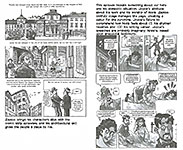 |
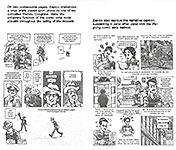 |
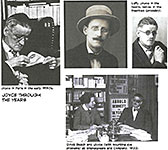 |
Zapico’s work is simply brilliant. It breathes with his mastery of comic strip style techniques and methods and his sure-footed storytelling—his stage management, timing, and pacing. His artwork, persuasive on every page, is nearly flawless. The incidents he has elected to enact are steeped in his research and thoroughness, and they also reveal an editor’s keen sense of selection.
Zapico’s James Joyce is easily the best graphic-novel style book of the season. Of any season.
